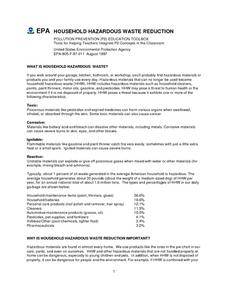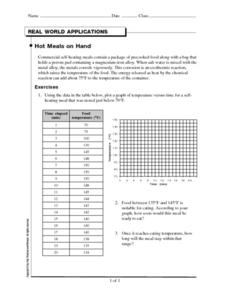Curated OER
Periodic Behavior of Oxides
High schoolers investigate the properties of oxides and observe their periodic trends. In this behavior of oxides lesson plan, students experiment with metallic oxides and non-metallic oxides to determine if they are acid, basic or...
Institute of Electrical and Electronics Engineers
Can You Copperplate?
Introduce emerging engineers to the process of metal plating. This resource provides background reading on chemical engineering, plating, and corrosion. It concludes with a copper plating activity. The standards alignment list includes...
Curated OER
What a Can Can Do
Students explore properties of cans (including aluminum and steel) as they rotate through stations. They experiment with magnets, weight differences, resistance to corrosion and temperature conductivity.
Teach Engineering
Alloy the Way to Mars
Future engineers test different alloys to determine the specific strength of each one. Based on the results, they make a recommendation to NASA on which alloy to use on engines for spacecraft.
Royal Society of Chemistry
Lead Compounds: Precipitation Reactions and Pigments—Microscale Chemistry
Colorful lead compounds never fail to impress! Solubility scholars examine a series of double replacement reactions involving lead nitrate and record their observations. The second part of the experiment illustrates the differences...
Curated OER
Aluminum and Titanium
Comparing aluminum and titanium, this PowerPoint gives the physical and chemical properties of each. Illustrations are used to assist in understanding. The notes are succinct, making this information a great model for chemistry or earth...
Curated OER
What a Can Can Do
Students explore the properties of a can. In this aluminum science lesson plan, students conduct various experiments to identify properties of aluminum. Students examine the appearance, temperature, and corrosion resistance of aluminum.
Curated OER
Rusting: A Form of Oxidation
Learners observe and record the corrosive nature of oxidation-reduction reactions, and determine the electro-chemical series of selected metals.
PBS
The Elements
An attractive handout displays the periodic table of elements in full color. Each group has its own color, and each element is represented by its name, chemical symbol, atomic number, and atomic weight. What makes this periodic table...
Curated OER
Magnets Challenge
In this magnets activity, students read 11 definitions that pertain to magnets. From four choices, students choose the word that matches each meaning.
Curated OER
Acids and Alkalis
This PowerPoint progresses slide-by-slide through all the facts you would want to deliver about acids, alkalis, salts, and the related lab tests. Each slide has one or two facts about a physical or chemical property or behavior. The...
Curated OER
Acids And Bases
In this acid and base chemistry worksheet, students solve 25 clues in a crossword puzzle based on the pH of common household solutions and common names of chemical compounds.
Curated OER
Household Hazardous Waste Reduction
Students discover the different types of hazardous waste. They examine ways to dispose of the hazardous materials safely and without harming the environment.
Curated OER
Chemical Composition of American Coins
High schoolers investigate the chemical composition of pennies dated 1983 or later. In this chemical composition of American coins lesson plan, students scratch the surface of the penny to expose the zinc core. They put the penny in...
Curated OER
Don't Let Hazardous Waste Be a Hazard to You!
In this recognizing hazardous waste worksheet, students observe hazard signs, read informational passages, and unscramble the words to identify hazardous waste products. Students unscramble 4 words.
Curated OER
Math Skills-Density
In this density worksheet, students learn about density and how to solve density problems. They calculate the mass, volume, or density in fifteen problems using what they learned.
Curated OER
Acids and Bases: Together again!
Students identify principles behind acid-base reactions. They predict factors that may affect an acid-base reaction. Students identify questions and concepts that guide scientific investigations.
Curated OER
pH Scale, acids and bases
Eighth graders define the pH scale, acids and bases. They distinguish between acidic and basic solutions using litmus paper. Students review simple chemical formulas. They define the subscript and coefficient in terms of chemical...
Curated OER
What Influences Reaction Rate?
Middle schoolers study reaction rates, what determines how fast a reaction happens and how the chemical changes occur. In this reactions lesson students complete a lab where they use Alka-Seltzer to observe reaction rate and create...
Curated OER
Sedimentary Size and Structures
Students interpret the Earth's history from models. In this investigative lesson students create sedimentary deposit models.
Curated OER
Vocabulary Practice for Week 2: The Call of the Wild
In this vocabulary worksheet, students learn 20 words in a list. Students answer 11 varied questions about the meanings of the words. Although it is not labeled with a title, these vocabulary words are related to The Call of the Wild by...
Curated OER
Science 9 Unit 3 Worksheet
In this chapters 2 and 3 science guided reading worksheet, students read corresponding material pertaining chemical reactions and the periodic chart answering 40 fill in the blank questions.
Curated OER
Hot Meals on Hand
In this exothermic reactions worksheet, students read about how commercial hot meals are heated through the use of exothermic reactions. They graph data of temperature and time elapsed for hot meals and answer two questions about the graph.
Curated OER
Look At A Landfill
Students explore how landfills function. For this landfill lesson, students explore the use of landfills and the decomposition process by creating a model landfill. Students discuss pros and cons to landfills and how potential problems...























